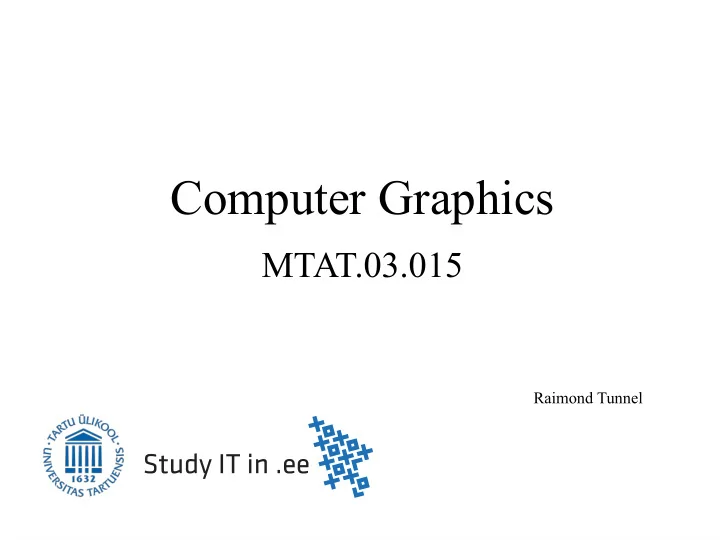

Computer Graphics MTAT.03.015 Raimond Tunnel
Course Information ● Course Page https://courses.cs.ut.ee/2016/cg/fall ● Mailing List aine.ati.arvutigraafika@lists.ut.ee ● Learning Environment (CGLearn) https://cglearn.codelight.eu/
Instructors ● Raimond Tunnel – jee7@ut.ee Lectures, Basic I, Basic II, JavaScript, C++ ● Margus Luik – mar6@ut.ee Basic I, C++ ● Jaanus Jaggo – jjaggo@ut.ee Blending, Procedural Generation, Noises ● Ats Kurvet – akurvet@ut.ee Game Engines, Unreal Engine 4 ● Timo Kallaste – timo.kallaste@gmail.com Blender
Organization ● 6 credit course ● Lectures: 15 1.5h = 22.5h = ~0.9 credits ⋅ ● Practice Sessions: 16 1.5h = 24h = ~0.9 credits ⋅ ● Homework: 2.3 credits = ~60h = 15 4h ⋅ ● Project: 40h = 1.5 credits ● Exam: 2h + 8h = ~0.4 credits
Organization ● Grade ● Homework: 40% Solve the tasks in CGLearn ● Project: 30% Do something fun in a 2-3 person team ● Exam: 30% General knowledge from the lectures / CGLearn
Organization ● Lectures – Tuesday, 16:15, r111 ● Practice Sessions ● Basic I (JS), Basic II – Thursday, 12:15, r003 ● Basic I (C++), Game Engines – Thursday, 14:15, r003 ● Project Presentation – In the exam session. TBA. ● Exam – In the exam session. TBA
Project ● Deadlines and instructions are here: https://courses.cs.ut.ee/2016/cg/fall/Main/Projects ● Can be any graphical application, prototype or a research project (e.g. replicating results from some paper). ● Extra ideas & time in the Computer Graphics Seminar (MTAT.03.305) and Computer Graphics Project (MTAT.03.316) courses. For inspiration see: https://www.youtube.com/watch?v=RDBv23Fc0w8
Modules ● Basic I G eometry, transformations, projection, lighting, texturing and blending. ● Basic II Environment mapping, curves, procedural generation, ray tracing, global illumination. ● Game Engines Unreal Engine 4 and Blender
Modules ● You should finish two of the modules to the end ● You can, of course, attend the other group and do their tasks for extra points (earning ~60% total).
Homework ● Each week we will cover topics in the practice sessions. ● Deadlines ● Basic I – 30.10.2016 ● Basic II, Game Engines – Week before the exam ● It is recommended, however, to do the homework weekly , because: ● You won't fall behind ● You will get the points sooner
Material ● CGLearn – https://cglearn.codelight.eu ● Material with interactive examples ● Tasks (homework) ● In the lectures we will cover similar topics that are in CGLearn (but not 100% overlapping) ● In the practice sessions we will discuss the concepts in tasks and start implementing them. CGLearn is my Master thesis work. There might be bugs, let me know immediately if you find some. :)
Material ● Fundamentals of Computer Graphcis P. Shirley, M. Ashikhmin, S. Marschner, 2009 ● Provides a good and systematic approach to many topics we cover. ● Explaines the math behind the topics. ● Who is interested in borrowing it?
Computer Graphics ● So, what is computer graphics? Applications?
Computer Graphics ● Games and entertainment Deus Ex, 2000 Deus Ex: Human Revolution, 2011
Computer Graphics ● Graphical user interfaces (GUI) Microsoft Word WinDirStat Photoshop
Computer Graphics ● Computer Aided Design (CAD) AutoCAD SolidEdge
Computer Graphics ● Scientific simulation visualization Philae lander landing on a comet http://www.esa.int/spaceinvideos/Videos/2013/12/Philae_touc h_down HIV particle http://www.scientificamerican.com/gallery/prize-winning-3-d-digital-simulation-of-an-hiv-particle/
Computer Graphics ● Data visualization World ocean currents, NASA http://deepbluehome.blogspot.com/2012/03/cool-cat-currents.html
Computer Graphics ● Simulations Road Planer Simulator (Maanteehöövli simulaator) Estonian Road Museum (Eesti Maanteemuuseum) http://muuseum.mnt.ee/ http://en.wikipedia.org/wiki/Flight_simulator
Computer Graphics ● Art Blithe Certainty by Kerry Mitchell http://www.fractalartcontests.com/2000/en/entry-052-3.htm
Technologies ● What to use to do graphics? ● 2D graphics? 3D graphics? ● Any previous experience?
Technologies ● We will start with lower-level technologies and libraries like: ● C++ – Allegro, OpenGL, GLFW, GLM ● JavaScript – Canvas, WebGL, Three.js ● Then you have a choice to continue with those or proceed with high-level modeling software and game engines: ● Blender, Unreal Engine 4
2D Technologies Language Language canvas < > HTML Element Library Browser Practice Session Group 2 Practice Session Group 1
3D Technologies Language Language Library Library GLFW , Three js . API API Practice Session Group 2 Practice Session Group 1
OpenGL, WebGL ● Those are API-s for communicating with the GPU drivers. ● WebGL is based on OpenGL ES 2 (Embedded Systems). ● They come with GLSL (Shader Language) which is used to program code executed on the GPU. It is similar to C language. Different calls to GPU Execute this code... GLSL code
OpenGL, WebGL https://www.khronos.org/assets/uploads/events/Next-Generation-OpenGL-Dec14.pdf
Standard Graphics Pipeline
Geometry ● Everything starts with the geometry ● Geometry defines the 3D objects in the scene
Geometry ● Although a cube has only 6 faces, we define it as a set of 12 triangles (12 faces). ● Why triangles?
Geometry ● Triangle very useful scientific facts: ● Triangle vertices always form a plane ● Every polygon can be converted to triangles ● Triangles are easy to rasterize ● Triangles are convex and simple ● Three vertices always form a convex and simple triangle . m r e t c i f i t n e i c s a s i s i h T
Geometry ● Convex polygon – 1) All convex combinations of the vertices are inside the polygon 2) Straight paths to all vertices from any point inside the polygon, are also inside the polygon 3) The polygon is equal to its convex hull 4) All interior angles are ≤ 180°
Geometry ● Simple polygon – no intersecting edges ● What is the difference between those triangles?
Geometry ● Coordinate system can be left-handed or right- handed. ● We usually use the right-handed system.
Geometry ● In a right-handed coordinate system, the positive direction of an angle is counter-clockwise. This means that the order of polygon vertices will define a front face and a back face.
What did you learn today? What more would you like to know? Next time: Geometry (points, vectors, coordinate systems, ...)
Recommend
More recommend